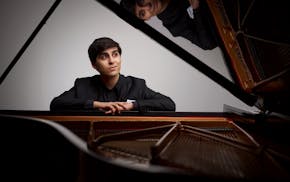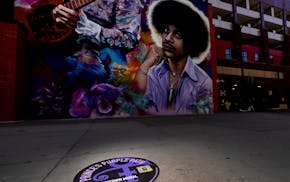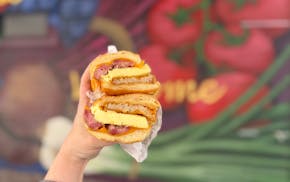Stop and smell the flowers. And while you're at it, take a look at some flowers in the shape of famous artworks.
Every year in late April, the hallways of the Minneapolis Institute of Art transform into a somewhat natural habitat. Local artists, florists and hobbyists alike pick an artwork at the museum and make it out of flowers.
Now in its 41st year, the four-day exhibition signals the start of spring (fingers crossed) and a new approach to seeing art.
"We have over 100,000 pieces of art in the collection, and the curators select what is up during Art in Bloom, and actual pieces of art that floral artists can select from," said Barbara Proeschel, president of the Friends of the Institute board, which organizes this event. "They also consider the museum's traffic patterns."
Of course, flowers can't overwhelm the museum. It is, after all, a place for preserving art.
"We can only have three [floral arrangements] per gallery, so that is another factor," Proeschel added.
Art in Bloom is the museum's most popular event all year long. But it lasts only four days, in part because flowers droop and die.
With more than 200 applicants, Mia uses a lottery system to make its selections. Artists who have previously done Art in Bloom get priority, but there's space for a total of 160 artists to create floral interpretations of artwork. These sit on pedestals next to the original pieces.
Another 16 commercial artists offer their interpretation of this year's signature piece, "Las vendedoras de flores" by Alfredo Ramos Martinez. This year, the museum wanted to celebrate Latin American Art. Two years ago, Mia hired Valéria Piccoli, its first curator of Latin American Art.
Flower fanatics
Richard Raiche has been contributing to Art in Bloom for 18 years, but he wasn't always an art guy. He jokingly referred to himself as a "dirt guy." He owns an engineering company.
A call from his sister Susie, a docent at Mia and concert pianist, changed his mind. That was 25 years ago.
"She would look at a picture and bring it to life, and I just fell in love with the museum," Raiche said. "And then she started bringing me to Art in Bloom, and I told Susie, 'I think I can do that,' and then she said to me, 'Well put your money where your mouth is,' and I did."
This year he interpreted an elevator door from the 1800s that used to be in the Chicago Grain Exchange building. He set to work creating a new structure: a miniature interpretation of the door as a birdcage, with an acrylic laser cut of the Chicago skyline in the background. There's also a cage with a dodo bird inside, purple-dyed roses at the bottom of the cage and an assortment of white and purple flowers surrounding it.
"Years ago, elevators were birdcages," Raiche said. "That's what they called them ... it wasn't like the elevators of today. You saw the shaft, you saw the cords, you saw the cables and everything. They looked like a birdcage. So I thought, why not do a birdcage?"
Down the hall, first-time Art in Bloom artist Diana Torgerson, a professional florist, stood next to a blue-and-white flower vase from the Netherlands, circa 1700. At that time, tulips were all the rage in Europe.
Blue is the rarest flower color, and her towering collection of flowers is filled with blue delphiniums. She thinks the piece will hold up, but it's different than making floral arrangements for other events.
"With weddings, it just needs to last a day," she said. "By Sunday afternoon, you'll see a couple shattered peonies."
Amber Tritabaugh, owner and designer of Haiku Flower Studio, put together her interpretation of the signature piece, Ramos Martinez's Mexican modernist painting of Indigenous women walking with baskets of flowers on their heads.
Inspired by the forms, colors, shapes and textures of the work, she broke it down into various design elements. One of the biggest challenges? The women themselves. One of the women looks at the viewer, and though it is a still image they are meant to look like they are in motion.
"That's why I've got flowers peeking through here and there," she said, pointing to her interpretation. "It's like someone's looking at us but we didn't really see it right away."
Art in Bloom
Where: Minneapolis Institute of Art, 2400 3rd Av. S., Mpls.
When: Thu.-Sun.
Hours: 10 a.m.-9 p.m. Thu., 10 a.m.-5 p.m. Fri.-Sun.
Cost: Free
Info: artsmia.org or 612-870-3000

Minneapolis native Evren Ozel advances to finals of Van Cliburn International Piano Competition

How many of Minneapolis' new 'Purple Path' sidewalk signs for Prince fans can you find?
![Pepe Willie stood for a portrait outside the Capri Theater, which is undergoing a major renovation, in Minneapolis. ] Shari L. Gross • shari.gross@s](https://arc.stimg.co/startribunemedia/4TPIVGPZLESDCIL3ZJ4J4T4ZDU.jpg?h=91&w=145&fit=crop&bg=999&crop=faces)
Pepé Willie, mentor to Prince and Morris Day, dies at 76

Your ultimate guide to eating and drinking in downtown St. Paul

